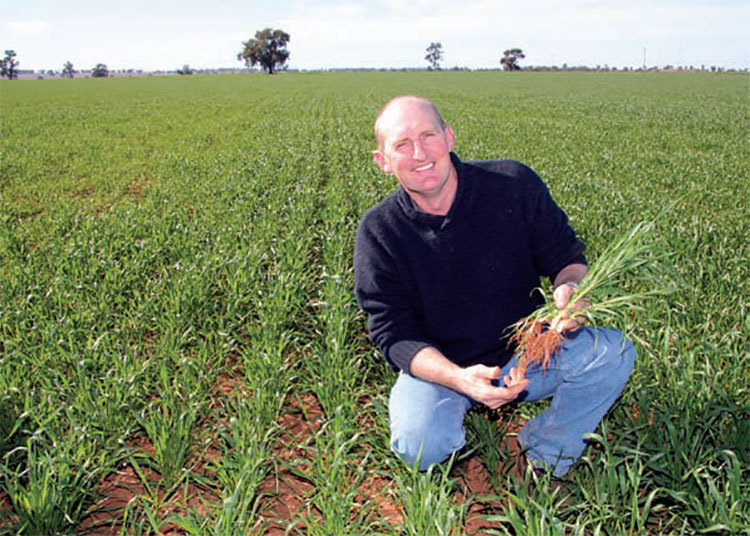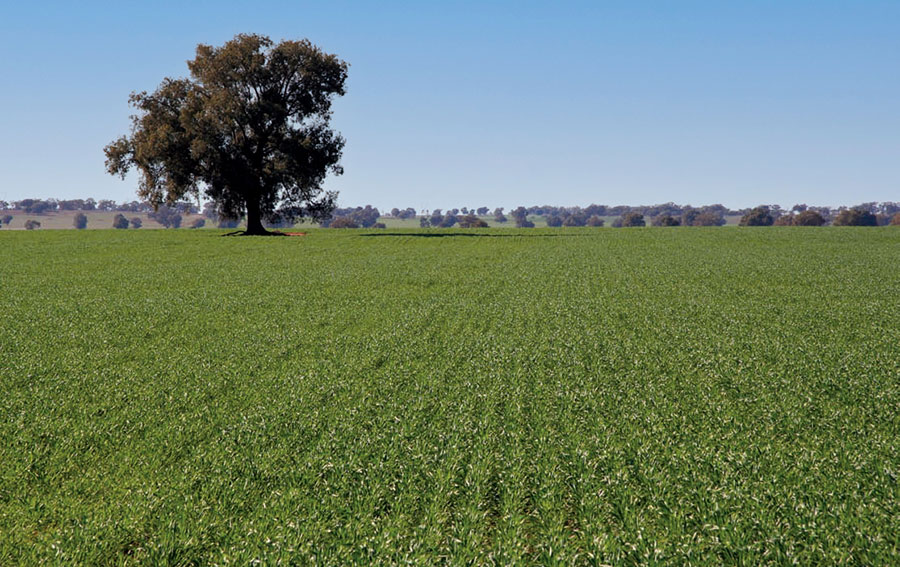
Case
Study
Location
Narrandera, New South Wales
Crop
Mixed farming
Healthy soils – healthy crops and livestock
Riverina mixed farmer, Drew Vidler, has noted a marked improvement in the health of his Merino sheep and the quality of their wool since he adopted a minimum-till biological farming system eight years ago.
Together with wife, Janelle, and children, Jock, Harrison and Alexandra, Drew runs 1200 Merino ewes on 1600 hectares of undulating sandy loam soils at ‘Coro’, Corobimilla, 20 kilometres south-west of Narrandera.
Half the property is sown to lucerne and clover based pastures while the remainder grows wheat, canola, barley and lupins. “When my family came here 46 years ago, the country was tired, with hard-setting, cloddy soils,” Drew said.

Drew Vidler checks Janz wheat sown eight weeks earlier at “Coro”, Corobimilla, NSW. The paddock grew canola the previous season after several years in pasture.
“Like everyone else in the area, they grew wheat. In those days, it seemed that the more they cultivated the better things got – but they didn’t know when to stop”
Drew’s father realised that the country was in trouble. In an effort to build up organic matter, he started retaining as much stubble and ground cover as possible and grew only one wheat crop in each paddock before sowing clover-based pasture on which to run Corriedale sheep. “By the time I took over, 20 years ago, we’d gone back to a bit of burning, mainly to control problem weeds, and instituted a four or five year cropping rotation that brought in canola,” Drew said.

Janz wheat sown eight weeks earlier on Drew Vidler’s farm, “Coro”, Corobimilla, NSW. The paddock grew canola the previous season after several years in pasture.
“We adopted minimum tillage and applied high rates of MAP and pre-drilled urea. We grew crops that looked beautiful but didn’t deliver the results at harvest. Things weren’t working the way they should have been. Obviously there was an imbalance somewhere.”
Things began to change in 1998, when Drew bought an AerWay aerator to break up hard crusts, flatten crop stubble and get air into the soil. His introduction to biological farming came the following year, when a neighbour grew a canola crop that yielded 2.82 tonnes per hectare – substantially better than the district average – using ‘biologically active’ fertilisers manufactured by Narrandera company, BioAg.
The company’s formulations not only provide a rich source of plant-available nutrients but also introduce beneficial microbes into the soil to produce a living, healthy and balanced soil for optimum plant and livestock productivity.
One of the company’s key products is BioAgPhos®, a reactive phosphate rock treated with a proprietary microbial culture to make it biologically active. About a third of its phosphorus content is available immediately for plant use, while the remainder is slowly digested by the micro-organisms and added to the nutrient reservoir in the soil.
The improved soil microbial activity is also claimed to help unlock phosphorus, calcium and sulphur already in the soil, leading to long-term benefits in soil structure and fertility.
Drew trialled the BioAg system in a canola paddock in 2000. The paddock was treated with one tonne per hectare of lime, 120kg per hectare of BioAgPhos, 100kg per hectare of sulphate of ammonia, 50kg per hectare of MAP, 3kg per hectare of zinc sulphate and 3L per hectare of BioAg Soil & Seed™, a liquid culture which encourages rapid germination, root development and soil microbial activity. “Soil tests showed this was one of our worst paddocks,” Drew said. “It was sandy, infertile and incapable of even growing a barley crop – yet it grew 2.5 tonnes per hectare of canola!
“It’s been a pretty good paddock ever since. We were sold on biological farming and have extended it over the entire farm. I decided to put every spare dollar into nutrients – although the spare dollars have been disappearing during the drought.”
He said the soils on ‘Coro’ were more friable and easy to work, whereas some paddocks used to contain clods the size of footballs. “Crop yields and quality have improved and screenings haven’t been a real problem, apart from last year,” he said.
“Weed problems have eased. We used to have problems with silver grass and capeweed but they’re quite manageable since we started improving the soil balance.” “We’ve had neighbours looking over the fence and a few of them are trying biological farming as well. We think a lot more will take it on now that conventional fertilisers are getting so expensive.”
Drew currently mates 850 of his Merino ewes to Merino rams for 22 micron wool production, while the remaining 350 ewes are joined to White Suffolk rams for a prime lamb enterprise.
Drew said the sheep showed a marked preference for BioAg-treated pasture in early comparison trials and had thrived on it ever since. “Our pastures seem more productive and sustainable and bounce back well after rain,” he said.
“Most of our pastures were lucerne based but we’ve reduced the amount of lucerne because it is so thirsty and in these dry years it doesn’t leave much soil moisture for a following crop.
“We’ve seen a big improvement in the health of the sheep and they seem to have fewer problems than they used to. Their wool quality seems to be better and we’re getting less tender wool, although we’ve improved our drought feeding regime as well.”
Download case study
Download a PDF version of the above case study.

Recent Comments